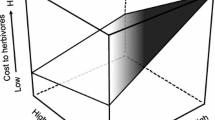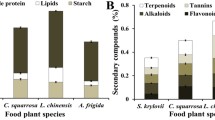Abstract
Plant secondary compounds can prevent feeding by phytophagous insects or, if ingested, can be poisonous to them. Less attention has been paid to the additional effects they have on feeding behavior when they are only weakly deterrent or not deterrent at all. Experiments were carried out on the generalist grass-hopperSchistocerca americana. Individuals were presented either with two cakes of high-quality artificial food with a single deterrent compound added or with two cakes, each with a different added deterrent compound. The deterrents consisted of single plant secondary compounds that were either marginally or strongly deterrent. There were profound differences in feeding behavior between those individuals given identical and those given different cake types, including longer feeding bouts on single cakes when a choice of different cake types was available. The behavioral effects demonstrate that the presence of secondary compounds in one food can influence the patterns of feeding on other available foods and suggest that such chemicals could impact foraging activities in a complex manner.
Similar content being viewed by others
References
Abisgold, J., and Simpson, S. J. (1987). The physiology of compensation by locusts for changes in dietary protein.J. Exp. Biol. 129 329–346.
Bernays, E. A. (1993). Aversion learning and feeding. In Papaj, D. R., and Lewis, A. C. (eds.),Insect Learning, Chapm and Hall, New York, pp. 1–17.
Bernays, E. A., and Bright, K. L. (1993). Dietary mixing in grasshoppers: A review.Comp. Biochem. Physiol. 104A 125–131.
Bernays, E. A., and Lee, J. C. (1988). Food aversion learning in the polyphagous grasshopperSchistocerca americana (Drury) (Orthoptera: Acrididae).Physiol. Entomol. 13 131–137.
Bernays, E. A., and Raubenheimer, D. (1991). Dietary mixing in grasshoppers: Changes in acceptability of different plant secondarly compounds associated with low levels of dietary protein.J. Insect. Behav. 4 545–556.
Bernays, E. A., Bright, K. L., Howard, J. J., Raubenheimer, D., and Champagne, D. (1992). Variety is the spice of life: The basis of dietary mixing in a polyphagous grasshopper.Anim. Behav. 44 721–731.
Bernays, E. A., Bright, K., Gonzalez, N., and Angel, J. (1994). Dietary mixing in grasshoppers: Tests of two hypotheses.Ecology 75 1997–2006.
Bright, K. L., and Bernays, E. A. (1991). Distinctive flavors influence mixing of nutritionally identical foods by grasshoppers.Chem. Senses 16 329–336.
Champagne, D., and Bernays, E. A. (1991). Phytosterol unsuitability as a factor mediating food aversion learning in the grasshopperSchistocerca americana.Physiol. Entomol. 16 391–500.
Chapman, R. F., and Beerling, E. A. M. (1990). The pattern of feeding of first instar nymphs ofSchistocerca americana.Physiol. Entomol. 15 1–12.
Chapman, R. F., Ascoli-Christensen, A., and White, P. R. (1991). Sensory coding for feeding deterrence in the grasshopperSchistocerca americana.J. Exp. Biol. 158 241–260.
Clarke, D. A. (1982). Foraging behavior of a vertebrate omnivore (Rattus rattus): Meal structure, sampling, and diet breadth.Ecology 63 763–772.
Frazier, J. (1986). The perception of plant allelochemicals that inhibit feeding. In Brattsten, L., and Ahmad, S. (eds.)Molecular Aspects of Insect-Plant Interactions, Plenum Press, New York, pp. 1–42.
Freeland, W. J., and Janzen, D. H. (1974). Strategies in herbivory by mammals: The role of plant secondary compounds.Am. Nat. 108 269–289.
Geissler, T. G., and Rollo, C. D. (1988). The influence of nutritional history on the response to novel food by the cockroach,Periplaneta americana.Anim. Behav. 35 1905–1907.
Jermy, T., Bernays, E. A., and Szentesi, A. (1982). The effect of repeated exposure to feeding deterrents on their acceptability to phytophagous insects. In Visser, J. H., and Minks, A. K. (eds.),Insect-plant Relationships, Pudoc, Wageningen, pp. 25–30.
Kraly, R. S., Carty, W. J., and Smith, G. P. (1978). Effect of pregastric food stimuli on meal size and intermeal interval in the rat.Physiol. Behav. 20 779–784.
Krebs, J. R., Kacelnik, A., and Taylor, P. (1978). Test of optimal sampling by foraging great tits.Nature 275 27–31.
Le Magnen, J. (1985).Problems of Behavioural Sciences: Hunger, Cambridge University Press, Cambridge.
Pietrewicz, A. T., and Richards, J. B. (1985). Learning to forage: An ecological perspective. In Johnson, T. D., and Pietrewicz, A. T. (eds.),Issues in the Ecological Study of Learning, LEA, London, 99–117.
Provenza, F. D., and Cincotta, R. P. (1993). Foraging as a self-organizational learning process: Accepting adaptability at the expense of predictability. In Hughes, R. N. (ed.),Diet Selection, Blackwell Scientific, London, pp. 78–100.
Rolls, B. J., Van Duijvenwoorde, P. M., and Rowe, E. A. (1983). Variety in the diet enhances intake in a meal and contributes to the development of obseity in the rat.Physiol. Behav. 31 31–28.
Rosenthal, G., and Berenbaum, M. (eds.) (1991).Herbivores. Their Interactions with Secondary Metabolites, Vols. I and II, Academic Press, New York.
Simpson, S. J. (1982). Patterns of feeding: A behavioural analysis usingLocusta migratoria nymphs.Physiol. Entomol. 7 325–336.
Sokal, R. R., and Rohlf, F. J. (1981).Biometry, Freeman, New York.
Szentesi, A., and Bernays, E. A. (1984). A study of behavioural habituation to a feeding deterrent in nymphs ofSchistocerca gregaria.Physiol. Entomol. 9 257–265.
Usher, B. F., Bernays, E. A., and Barbehenn, R. V. (1988). Antifeedant tests with larvae ofPseudaletia unipuncta: Variability of behavioral response.Entomol. Exp. Appl. 48 203–212.
Author information
Authors and Affiliations
Rights and permissions
About this article
Cite this article
Bernays, E.A., Gonzalez, N., Angel, J. et al. Food mixing by generalist grasshoppers: Plant secondary compounds structure the pattern of feeding. J Insect Behav 8, 161–180 (1994). https://doi.org/10.1007/BF01988902
Accepted:
Issue Date:
DOI: https://doi.org/10.1007/BF01988902




